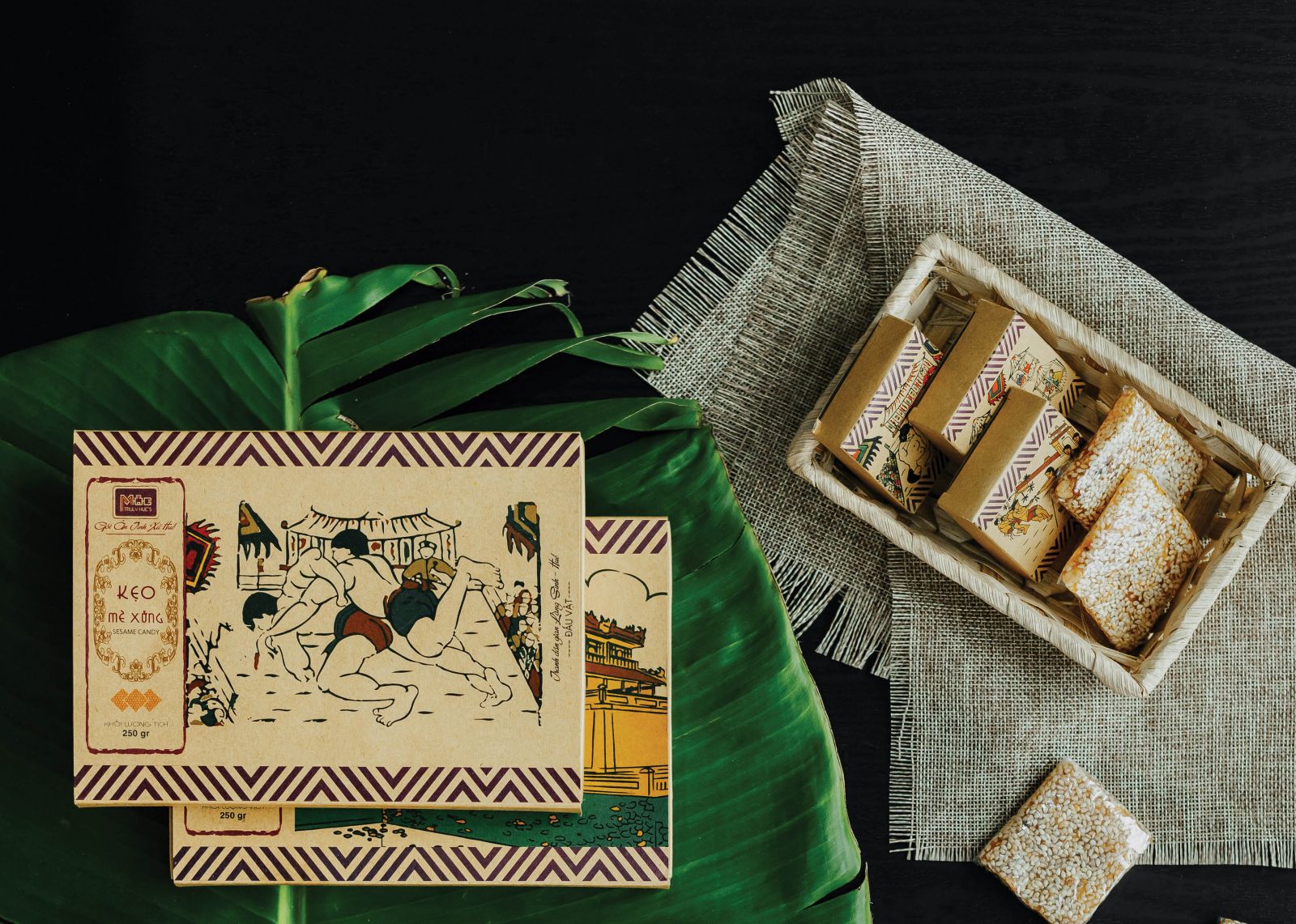
Products “blown soul into” from the packaging
Preparing to return to Ho Chi Minh City, after a succession of days of visiting the hometown, my girlfriend said she wanted to buy some Hue specialties as gifts. Amidst the countless specialties, she stopped for long, fingered a box of kẹo cau (candy in the shape of one-fourth of an areca nut). “Are my teeth hard enough to eat the candy?"
Instead of being wrapped in banana leaves or newspapers, kẹo cau are neatly arranged in small boxes. The owner of Hue specialty store - Mộc Truly (Moc for short) - Pham Thi Dieu Huyen said, "I want every Hue specialty to be cherished like a beautiful memory."
Perhaps for that reason, out of the 15 products Dieu Huyen selects to improve design and declare quality, each product has an enjoyable story.
According to a survey, more than 60% of customers will have a liking for the brands which build humane, distinctive images and stories, and tend to buy the products that contain attractive contents and messages. That is why some businesses choose to incorporate the cultural value into their products to "identify" their goods.
Those who love the culture of A Luoi uplanders may have heard about the epic story of A Chat by the Ta Oi people. However, little is known about the story of this hero also incorporated into each Zèng product as a cultural symbol, creating a distinguishing feature for each product or a way to differentiate Zèng from the brocade of other lands.
For example, Zèng scarf by Nham Cooperative has a pattern about A Chat boy’s love with a rich, beautiful girl. Overcoming many challenges, they could be together.
Ms. Le Thi Kim Thoai, Director of Nham Commune Brocade Cooperative said the brocade textile products across the country have similarities. However, the position of some motifs on the material base represents the identity of each ethnic group.
For instance, the Zèng scarf tells an ancient story through the Ngkoang kating pattern (the kating old tree), a symbol of the Pârsee slope (the immortal love slope), which marks the poor, orphan boy’s love for a beautiful, talented girl.
"Through the motif shaped with red or beaded zigzag lines, we desire to tell about the unique culture of A Luoi land that can be found nowhere," said Ms. Thoai.
Incorporating stories into local specialties not only takes the culture away but also is a way of touching the emotions of many people.
Back to the story of my girlfriend from Saigon, who chose mứt gừng (ginger jam), kẹo cau (candy in the shape of one-fourth of an areca nut)... made by Moc as gifts, she shared the reason: "Not only for eating but also for enjoying."
The owner of Moc Truly said when selling products to customers, she desires to introduce them to the cultural and historical stories so that customers can understand and cherish the products more.
As is the story of Moc's mứt gừng, the owner of this brand chooses the image of Kim Long mứt gừng craft village and the famous Tuan ginger-growing area at the Huong River conflux. Aside from the story, Moc also produces the designs imbued with Hue identity. For example, the images of áo dài (a long-sleeved tunic with ankle-length panels at front and back), nón lá (a palm-leaf conical hat), Sinh Village paintings, and lotus paintings are inserted into each product.
"Holding a box of mứt gừng (ginger jam), sen sấy (dried lotus seeds) ... with the image of a girl in ao dai, the box lid made of Huong Toan nón lá, Moc desires to tell customers the story of ao dai and nón lá with Hue cultural feature. Above all, it is also the pride of the cultural identity and people of Hue,” Ms. Huyen said.
From the perspective of research, Dr. Tran Dinh Hang - Deputy Director of the National Sub-Institute of Culture and Arts in Hue said that Hue specialties need to be retold in the form of stories. For example, Ham Huong fish sauce of An Bang Village is a grace that marks the tradition of marine troops established by the new land developers who ritually took Nguyen Lord to the South
Geographical names must exist in products, and products must contain the stories bearing the hallmarks of geographical names with many historical and cultural values. An item at that time is no longer purely a product but a native product, a specialty of a land or a cultural area.
Minister of Agriculture and Rural Development Nguyen Xuan Cuong during the survey trip in Thua Thien Hue also noted, “A product that has a foothold in the market is not only of good quality, ensured in food safety and hygiene…; it is important that it can reflect the hallmark of each locality and enhance the traditional value of each land, each community.”
The "difference or death" marketing philosophy of business gurus remains valid in the market battle. Whether a product's name is remembered or not depends on how the business touches the customer's emotional level, not just the matter of “after the feast coming the reckoning”. This is what many businesses in Hue have been aiming for in order to leave a deep impression of their brand in the hearts of customers.
Story and photo: Hoang Loan
